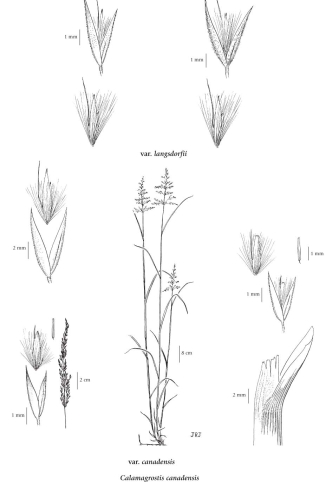Calamagrostis canadensis (Michx.) P. Beauv.
bluejoint reedgrass (bluejoint)
Poaceae (Grass family)
Introduction to Vascular Plants
bluejoint reedgrass (bluejoint)
Poaceae (Grass family)
Introduction to Vascular Plants
SUBTAXA PRESENT IN BC
Species Information
General:
Perennial grass from fibrous roots and rhizomes; stems 60-150 cm tall, smooth, with 3 to 8 nodes, often branching above.
Leaves:
Sheath summits smooth to strongly hairy; leaf blades lax, usually flat, rough on both surfaces, often glaucous above, 5-30 cm long, mostly 3-8 mm wide; ligules mostly 3-8 mm long, with jagged margins.
Flowers:
Inforescence an open, lax or sometimes narrow panicle 10-25 cm long, the longer branches 3-8 cm long, sparsely- to densely-flowered on the upper 1/2; spikelets 1-flowered; glumes usually purple-tinged, thin, translucent along the margins, sharp- to long-pointed, usually rough, often bristly on the keels; lemmas thin, 2.5-4.5 mm long, with delicate, straight awns attached just below the middle and extending to or just beyond the tips, the callus hairs copious, mostly of uniform length, about as long as the lemmas; paleas thin, 1/2 to almost as long as the lemmas; rachillas short, inconspicuous, sparsely bearded with long hairs.
Notes:
Two intergrading varieties are recognized in BC and delimitation of each is arbitrary. Variety langsdorfii also intergrades with C. lapponica. The two varieties may be separated as follows:
1. Glumes 3-4 mm long, inconspicuously rough and thin, the keels lacking bristlelike hairs, translucent on the margins; awns thin, not prominent.................... var. canadensis
1. Glumes 4-6 mm long, conspicuously rough, the keels with bristlelike hairs, usually not translucent on the margins; awns thick, more prominent.................. var. langsdorfii (Link) Inman
Illustration

If more than one illustration is available for a species (e.g., separate illustrations were provided for two subspecies) then links to the separate images will be provided below. Note that individual subspecies or varietal illustrations are not always available.
Illustration Source: The Illustrated Flora of British Columbia
USDA Species Characteristics
Flower Colour:
Green
Blooming Period:
Late Spring
Fruit/Seed characteristics:
Colour: Yellow
Present from Summer to Fall
Source: The USDA
Ecology
Ecological Framework for Calamagrostis canadensis
The table below shows the species-specific information calculated from
original data (BEC database) provided by the BC Ministry of Forests and Range.
(Updated August, 2013)
The table below shows the species-specific information calculated from
original data (BEC database) provided by the BC Ministry of Forests and Range.
(Updated August, 2013)
| Site Information |
Value / Class |
||
|
Avg |
Min |
Max |
|
| Elevation
(metres) |
1098 | 0 | 2420 |
| Slope
Gradient (%) |
9 | -5 | 200 |
|
Aspect (degrees) |
178 | 0 | 360 |
| Soil
Moisture Regime (SMR) [0 - very xeric; 4 - mesic; 8 - hydric] |
5 | 0 | 8 |
| Modal
Nutrient Regime
Class |
C | ||
| #
of field plots species was recorded in: |
5807 | ||
| Modal
BEC Zone Class |
SBS | ||
|
All BEC Zones (# of stations/zone) species was recorded in |
AT(5), bafa(35), BG(3), BWBS(762), CDF(1), CMA(4), CWH(130), ESSF(1358), ICH(560), IDF(197), IMA(1), MH(45), MS(453), PP(8), SBPS(167), SBS(1659), SWB(142) | ||
|
Source:
Klinkenberg 2013
|
|||